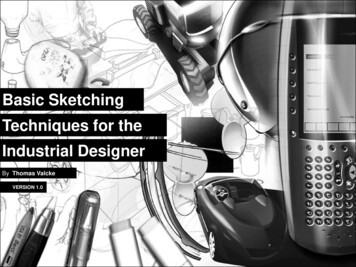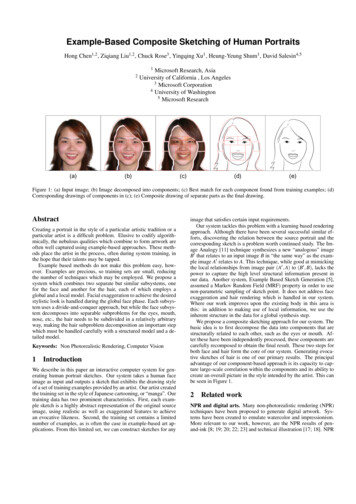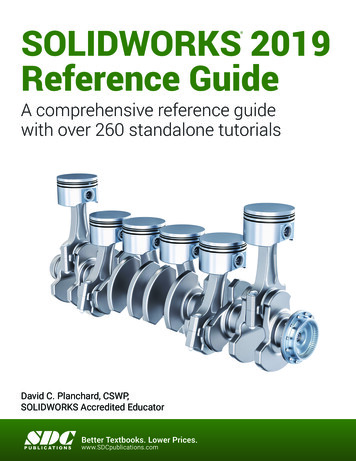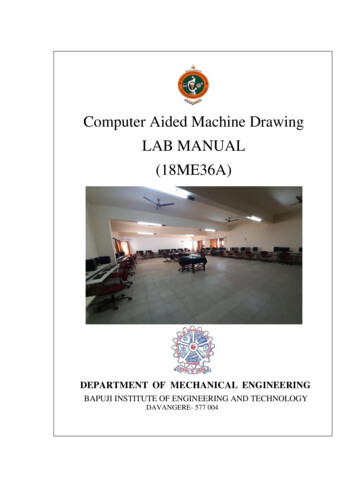
Transcription
Cathy Johnson’s Mini-classesquick sketching techniques -1LESSON ONE–what, why, and basicsThere is a great interest in fast sketching these days!That’s not too surprising given the fact that we are all busyand may need to squeeze creativity into odd moments.Perhaps our crowded schedule just allows for 15 minutes ora half hour of creative time, or we’re traveling with nonsketchers who may become impatient, or what has caughtour eye tends to move frequently, like the crows at right–inall those cases, fast sketching is a very useful tool. It justHere you see a variety of quick sketchingtakes practice.and practice will build speed, confidence,techniques.colored pencil, pen, pencil,and ability. That IS win-win.watercolor.One benefit of this type of sketching is that it keeps your hand/eye coordination in fighting trim.It’s simply great practice. As Michelangelo said to his apprentice, "Draw, Antonio; draw,Antonio; draw and don't waste time."Of course definitions of “quick sketching” vary from artist to artist. I may think of a 15-secondgesture sketch as truly fast; 5-10 minutes defines it to some, and Alwyn Crawshaw’s wonderfullittle book, Sketching (30 minute art) from the Smithsonian, is another approach.Of course, what comprises this kind of sketching (aswell as exactly what that means under a specificcircumstance) depends somewhat on your subjectand its complexity, the medium you’re using, andhow much time you have at your disposal. 30minutes can be quite fast, if you’re doing a complexscene in watercolor–it still qualifies as a sketch! Idid the small one at left on the spot in less than 30minutes.Quick Sketching Techniques, Cathy Johnson, all rights reserved1
I’m often asked what the difference is between sketchingand drawing. A drawing can be quite detailed, careful, andmay be most realistic. Sketching, as David Rankin, authorof Fast Sketching Techniques says, is “intense, loose, rapid,and spontaneous.”A drawing may capture an almost photographic likeness–asketch may catch some spark of life–I often prefer artists’sketches to their more formal works; see Work Small, LearnBig if you want to see some inspiring sketches!This graphite portrait of myhusband in his RevolutionaryWar reenacting clothes is verydefinitely a drawing.it tookhours, with shading, blending,adjusting.Here, the broom on the left is avery quick sketch, and took onlyseconds–the one on the right ismore properly a drawing. I tookmy time.These shoppers in the Half Price Books store, on the otherhand, are quick sketches. I used an old fountain pen with aflexible nib for them and worked as fast as I could.thegesture sketches in Lesson Two are even faster.This colored pencilblue jay on blackpaper was even faster!Quick Sketching Techniques, Cathy Johnson, all rights reserved2
Quick sketching catches something of the essence of a subject in ways that slower, moredeliberate drawings may miss. You simply don’t have time to muddy the waters or confuse yourimage with too much detail.And it’s exciting when you DO nail it!Quick sketching also helps defeat that Inner Critic we all carry with us. No time to agonize orworry if we’ve got it “right,” we just get ON with it.So.let’s get at it.FAST!We’ll start out with simple supplies for this first lesson–that will give you time to gather whatyou want and play a bit. (More supplies later!)BASIC SUPPLY LISTTo begin with, just get a pencil, a pen,and something to draw on. Fast canoften equate with simple.I branched out a bit for this drawing;you may have seen it in my book, TheSierra Club Guide to Sketching inNature. A pencil or two, a pen if youlike, a sharpener if your pencil calls forone, and an eraser are fairly basic!A #2 pencil has a fair range of values,doesn’t smear too much, and holds apoint; many artists prefer a much softerone, 6B to 9BBE PREPAREDAt the risk of sounding like a Boy Scout, being prepared to make art, any time, any place, is oneof our best tools for quick sketching. It’s more than having all the supplies you might thinkof–it’s more a state of readiness.Quick Sketching Techniques, Cathy Johnson, all rights reserved3
Keep it simple, especially to begin with. Choose a drawing tool you like, or one you are familiarwith. One that feels right in your hand. Never mind archival properties just now, or the latest“must-have” drawing tool. If a good old #2 school pencil is comfortable for you, fine. If you likea ballpoint–or if that’s all that’s handy–use it! If a mechanical pencil feels good in your hand andyou love the convenience, carry that. (An added advantage is that you don’t have to stop tosharpen it, or carry a sharpener with you! Advance the lead a bit, and GO.)My usual quick-sketching tool is an 0.7mm mechanical pencil with a nice, big, soft vinyl eraser(for those times when I just HAVE to do it!) I’ll admit I do try to replace the HB leads with 2B ifI can find them–it’s a bit softer and more blendable. It’s also capable of a broader range ofvalues.All I had time for at Las Vegas’ McCarron Airport were quick sketches of my fellowpassengers with a ballpoint pen. They moved constantly; the fellow in the middle isactually a composite of two people! I was able to get the poses and a suggested on lightsand darks with the pen, and added color at home, later.Quick Sketching Techniques, Cathy Johnson, all rights reserved4
Paper can be anything handy–a sketchbookor journal filled with paper you love isgreat, but the back of an envelope ordeposit slip, wrapping paper, a papernapkin, or the margin of a sheet of paperfrom your printer works too–the importantthing is to DO it when the opportunitystrikes!I was making notes on this class when myneighbor’s cat came by for a visit–he gotsketched in the margin, with that samepurple pen! Great art? No. Fun? YES!!And it captured that moment like nothingelse could.Paper or sketchbook size really doesn’tmatter–some artists are comfortablecarrying a 9" x 12" journal, others prefer apocket size. Use what you’re most likely tokeep at hand!Tip: Mark your place with a rubber band, ribbon, or bookmark so you can open yoursketchbook to the next empty page–FAST.NOTE: Paper that is too rough, like some handmade watercolor papers, may make yourpen or pencil skip over that bumpy surface. If that bothers you or slows you down toomuch, try a smoother paper. TOO smooth is sometimes frustrating as well.like theThree Bears, go for “juuuuuust right!” That means just right for YOU–it’s a personaldecision, of course.The important thing is to be prepared–have sketching supplies always handy, even if that justmeans a pencil and piece of paper.If you’re not prepared, be flexible! Grab what’s at hand–I’ve drawn on the backs of envelopes, apaper napkin, a grocery bag (paper, of course!)Keep these sketches, too–I often paste them in my journal rather than throwing them out. Theyrecord something spontaneous that I often enjoy looking at later.Quick Sketching Techniques, Cathy Johnson, all rights reserved5
QUICK-SKETCH TIPS!Simple sketching tools are fast and easy to deal with, especially if you plan tosketch on the spot rather than home in the studio.the more you have to dig for,get out and get ready, the less time you’ll have for actual sketching. You can haveas much stuff as you want (or can afford!) in your studio, but for quick sketching,be ready to go at a moment’s notice. I carry a favorite pen, a mechanical pencil,and a colored pencil in a wee pocket right at the top of my purse, easy to find andeasy to get at.!Keep your supplies organized at home, to make them easier to findquickly.pencils in a mug, pencil holder, box, or held together with a rubber band.!Keep sketching tools inevery room (if you useinteresting jars, mugs, vaseswhatever, this will even addto your decor instead oflooking messy!) I often takemy journal to bed with me,and do a quick sketch beforebed or on waking–I keep amug with a few pens andpencils, and the world’ssmallest watercolor set, plusa water brush on the bedsidetable.!Keep sketching tools in yourvehicle as well. I have a tinyfolding sketch journal, acouple of pencils, and even atiny watercolor set in theglove box of both ourvehicles. I don’t usuallyleave home withoutsketching materials in mybag, but I HAVE.and I’mready, in that case.Quick Sketching Techniques, Cathy Johnson, all rights reservedA FEW MORE SUPPLIESIf you want to go a bit beyond thebasics, consider:2B, 4B and 6B drawing pencilsFlat sketching pencil (you may want4B to 6B or softer for this too).05 mechanical pencilPrismacolor (or other brand) coloredpencil in a dark colorBallpoint penPencil sharpenerSoft white vinyl eraser–you man notneed it, but hey.Paper of your choice.remember thattoo rough paper may be frustratingas your pencil or pen may skip.6
EXERCISE:EXPERIMENT. Play with your materialsa little. Try them out. See what kind ofmarks you can get with that pencil, penor brush pen.Vary how you hold your drawing tool(we’ll talk more about that in LessonTwo.Try varying amounts of pressure (softpencils may break, with too muchpressure, though.)The more familiar you are with yourtools, the faster you can make them doyour bidding!Check out these quick videos:Test driving your tools:http://www.youtube.com/watch?v 1a-nbpra5CEDeciding which one to choose for speed: http://youtu.be/PbWt1pR203YGet Ready, Get Set, DRAW!Try different ways to store or carry your tools so they’re ready at all times, whenever youare–“Fast Draw McGraw” isn’t just a cartoon character!And make a note of what works for you! Take a look at what other sketchers do. I often getgreat ideas from sketching with others.Quick Sketching Techniques, Cathy Johnson, all rights reserved7
BONUS EXTRAS, books, links and more:Many of the books I link to have the “look within” feature on Amazon–be sure to hit the“surprise me” link, and scroll down, you can see MUCH more.David Rankin, Fast Sketching TechniquesAlwyn Crawshaw, 30 Minute SketchingDanny Gregory, An Illustrated Life at this link (yep, one of the images on the cover is mine!)Sketchbook Confidential. The variety and types of sketches are bound to inspire you.And many, many more, of course.you’ll see additional suggestions in upcoming classes.Quick Sketching Techniques, Cathy Johnson, all rights reserved8
of Fast Sketching Techniques says, is “intense, loose, rapid, and spontaneous.” A drawing may capture an almost photographic likeness–a sketch may catch some spark of life–I often prefer artists’ sketches to their more formal works; see Work Small, Learn Big if you want to see some inspirin









